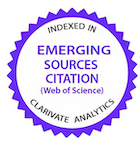Efeitos de diferentes estratégias de restrição alimentar sobre as concentrações de hormônios, metabólitos e minerais de machos Holandês × Zebu não castrados em terminação
DOI:
https://doi.org/10.1590/1809-6891v21e-63329Resumo
Objetivou-se avaliar os efeitos de diferentes estratégias de alimentação restrita sobre as concentrações sanguíneas de hormônios, metabólitos e minerais de machos Holandês × Zebu castrados em terminação. Vinte machos Holandês × Zebu castrados (peso corporal inicial [PC] = 319 ± 16,2 kg; idade = 19 ± 1 meses) foram aleatoriamente distribuídos em 4 grupos de 5 animais, os quais receberam alimentação restrita a 85% do consumo ad libitum por 0 (R0; n=5), 28 (R28; n=5), 42 (R42; n=5) ou 84 (R84; n=5) dias. Os animais foram alojados individualmente e considerados como unidades experimentais. Amostras de sangue foram coletadas nos dias 0, 21, 42 e 84, e analizadas quanto às concentrações de fator de crescimento semelhante à insulina 1 (IGF-1), hormônios tireiodianos (T3 e T4), albumina, creatinina, ureia, proteína total, glicose, triglicerídeos, cálcio e fósforo. Animais que receberam alimentação restrita apresentaram aumento nas concentrações de IGF-1 até o dia 42 (P < 0,05). Animais R84 apresentaram as maiores (P < 0,05) concentrações de IGF-1 no dia 84. As concentrações de ureia foram maiores (P < 0,05) para os animais AL84 e menores (P < 0,05) para os animais R28; os animais R42 e R84 apresentaram valores intermediários e não diferentes (P > 0,05) entre si. As concentrações de IGF-1, ureia, albumina, e calcium, mas não as de T3, T4, glicose, triglicerídeos, creatinina, proteína total e fósforo, foram influencias pelas diferentes estratégias de alimentação restrita utilizadas em machos Holandês × Zebu castrados em terminação.
Palavras-chave: Balanço Mineral; Bovinos Cruzados; Consumo Alimentar Restrito
Downloads
Referências
Galyean ML. Review: Restricted and programmed feeding of beef cattle-definitions, application, and
research results. PAS. 1999; 15:1–6.
Carstens GE, Johnson DE, Ellenberger MA, Tatum JD. Physical and chemical components of the empty
body during compensatory growth in beef steers. J Anim Sci. 1991; 69:3251–64.
Hornick JL, Van Eenaeme C, Diez M, Minet V, Istasse L. Different periods of feed restriction before
compensatory growth in Belgian Blue bulls: II. Plasma metabolites and hormones. J Anim Sci. 1998;
:260–71.
Felix TL, Radunz AE, Loerch SC. Effects of limit feeding corn or dried distillers grains with solubles at
intakes during the growing phase on the performance of feedlot cattle. J Anim Sci. 2011; 89:2273–79.
Hornick JL, Van Eenaeme C, Gérard O, Dufrasne I, Istasse L. Mechanisms of reduced and compensatory
growth. Domest Anim Endocrinol. 2000; 19:121–32.
Wilson PN, Osbourn DF. Compensatory growth after undernutrition in mammals and birds. Biol Rev.
; 35:324–61.
Mahyuddin, P. Compensatory growth in ruminants. Anim Prod. 2004; 6:125–35.
Ellenberger MA, Johnson DE, Carstens GE, Hossner KL, Holland MD, Nett TM, Nockels CF. Endocrine and
metabolic changes during altered growth rates in beef cattle. J Anim Sci. 1989; 67:1446–54.
Yambayamba ES, Price MA, Foxcroft GR. Hormonal status, metabolic changes, and resting metabolic
rate in beef heifers undergoing compensatory growth. J Anim Sci. 1996; 74:57–69.
Keogh K, Waters SM, Kelly AK, Wylie A RG, Sauerwein H, Sweeney T, Kenny DA. Feed restriction and
realimentation in Holstein-Friesian bulls: II. Effect on blood pressure and systemic concentrations of
metabolites and metabolic hormones. J Anim Sci. 2015; 93:3590–3601.
Keogh K, Waters SM, Kelly AK, Kenny DA. Feed restriction and subsequent realimentation in Holstein
Friesian bulls: I. Effect on animal performance; muscle, fat, and linear body measurements; and slaughter
characteristics. J Anim Sci. 2015; 93:3578–89.
Silva FAS, Valadares Filho SC, Godoi LA, Silva BC, Pacheco MVC, Zanetti D, Benedeti PDB, Silva FF,
Felix TL. Effect of duration of restricted-feeding on nutrient excretion, animal performance, and carcass
characteristics of Holstein × Zebu finishing steers. Anim Prod Sci. 2020; 60:535–544.
Valadares Filho SC, Costa e Silva LF, Gionbelli MP, Rotta PP, Marcondes MI, Chizzotti ML, Prados
LF. Nutrient Requirements of Zebu and Crossbred Cattle - BR-CORTE. 3rd ed. Visconde do Rio Branco:
Suprema Gráfica Ltda.; 2016. 314p. English.
Hoch T, Begon C, Picard B. Mécanismes et conséquences de la croissance compensatrice chez les
ruminants. INRA Prod Anim. 2003; 16:49–59.
Hayden JM, Williams JE, Collier RJ. Plasma growth hormone, insulin-like growth factor, insulin, and
thyroid hormone association with body protein and fat accretion in steers undergoing compensatory
gain after dietary energy restriction. J Anim Sci. 1993; 71:3327-3338.
Blum J W, Schnyder W, Kunz PL, Blom AK, Bickel H, Schürch A. Reduced and compensatory growth:
Endocrine and metabolic changes during food restriction and refeeding in steers. J Nutr. 1985; 115:417–
Breier BH. Regulation of protein and energy metabolism by the somatotropic axis. Domest Anim
Endocrinol. 1999; 17:209–18.
Hossner KL. Hormonal regulation of farm animal growth. Cambridge: CABI Publishing; 2005. 240p.
English.
Preston R, Schnakenberg D, Pfander W. Protein utilization in ruminants: I. Blood urea nitrogen as
affected by protein intake. J Nutr. 1965; 86:281–88.
Kohn RA, Dinneen MM, Russek-Cohen E. Using blood urea nitrogen to predict nitrogen excretion and
efficiency of nitrogen utilization in cattle, sheep, goats, horses, pigs, and rats. J Anim Sci. 2005; 83:879–89.
Russell KE, Roussel AJ. Evaluation of the ruminant serum chemistry profile. Vet Clin North Am Food
Anim Pract. 2007; 23:403–26.
Kaneko JJ, Harvey JW, Bruss ML. Clinical biochemistry of domestic animals. 6th ed. San Diego: Academic
Press; 2008. 928p. English.
Bass JJ, Oldham JM, Hodgkinson SC, Fowke PJ, Sauerwein H, Molan P, Breier BH, Gluckman PD. Influence
of nutrition and bovine growth hormone (GH) on hepatic GH binding, insulin-like growth factor-I and
growth of lambs. J Endocrinol. 1991; 128:181–86.
Mcguire MA, Vicini JL, Bauman DEP, Veenhuizent JJ. Insulin-like growth factors and binding proteins in
ruminants and their nutritional regulation. J Anim Sci. 1992; 70:2901–10.
Ronge H, Blum J. Insulin-like growth factor I responses to recombinant bovine growth hormone during
feed restriction in heifers. Acta Endocrinol. 1988; 120:735–44.
Oksbjerg N, Gondret F, Vestergaard M. Basic principles of muscle development and growth in meatproducing
mammals as affected by the insulin-like growth factor (IGF) system. Domest Anim Endocrinol.
; 27:219–240.
Rowlands GJ. A review of variations in the concentration of metabolites in the blood of beef and dairy
cattle associated with physiology, nutrition and disease, with particular reference to the interpretation of
metabolic profiles. World Rev Nutr Diet. 1980; 35:172–235.
Reinhardt TA, Horst RL, Goff JP. Calcium, phosphorus, and magnesium homeostasis in ruminants. Vet
Clin North Am Food Anim Pract. 1988; 4:331–50.
NRC. Nutrient requirements of beef cattle. 7th ed. Washington: Nat. Acad. Press; 2000. 248p. English.
Berchielli TT, Pires AV, Oliveira SG. Nutrição de Ruminantes. 2nd ed. Jaboticabal: Editora Funep; 2011.
p. Portuguese.
ages and stages of lactation. Can J Vet Res. 1988; 52:99–105.
McDowell LR. Minerals in Animal and Human Nutrition. 2nd ed. Amsterdam: Elsevier; 2003. 660p.
English.
Eisemann JH, Huntington GB, Catherman DR. Insulin sensitivity and responsiveness of portal-drained
viscera, liver, hindquarters, and whole body of beef steers weighing 275 or 490 kilograms. J Anim Sci.
; 75:2084–91.
Radunz AE, Fluharty FL, Relling AE, Felix TL, Shoup LM, Zerby HN, Loerch S C. Prepartum dietary
energy source fed to beef cows: II. Effects on progeny postnatal growth, glucose tolerance, and carcass
composition. J Anim Sci. 2012; 90:4962–74.
Kleiber M. Body size and metabolic rate. Physiol Rev. 1947; 27:511–41.
Rolfe DFS, Brown GC. Cellular energy utilization and molecular origin of standard metabolic rate in
mammals. Physiol Rev. 1997; 77:731–58.
Hulbert AJ, Pamplona R, Buffenstein R, Buttemer WA. Life and death: metabolic rate, membrane
composition, and life span of animals. Physiol Rev. 2007; 87:1175–1213.
Samuelson KL, Hubbert ME, Galyean ML, Löest CA. Nutritional recommendations of feedlot consulting
nutritionists: The 2015 New Mexico State and Texas Tech University survey. J Anim Sci. 2016; 94, 2648–63.
Ferraz JBS, Felício PE. Production systems - An example from Brazil. Meat Sci. 2010; 84:238–43.
Downloads
Publicado
Como Citar
Edição
Seção
Licença
Copyright (c) 2020 Ciência Animal Brasileira

Este trabalho está licenciado sob uma licença Creative Commons Attribution 4.0 International License.
Autores que publicam nesta revista concordam com os seguintes termos:
- Autores mantém os direitos autorais e concedem à revista o direito de primeira publicação, com o trabalho simultaneamente licenciado sob a Licença Creative Commons Attribution que permite o compartilhamento do trabalho com reconhecimento da autoria e publicação inicial nesta revista.
- Autores têm autorização para assumir contratos adicionais separadamente, para distribuição não-exclusiva da versão do trabalho publicada nesta revista (ex.: publicar em repositório institucional ou como capítulo de livro), com reconhecimento de autoria e publicação inicial nesta revista.
- Autores têm permissão e são estimulados a publicar e distribuir seu trabalho online (ex.: em repositórios institucionais ou na sua página pessoal) a qualquer ponto antes ou durante o processo editorial, já que isso pode gerar alterações produtivas, bem como aumentar o impacto e a citação do trabalho publicado (Veja O Efeito do Acesso Livre).






























